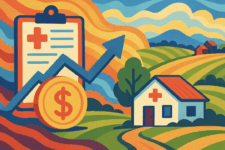Timmaron Group has had much experience in healthcare. Our “Community Care” model has been adopted successfully in more than 1,000 U.S. counties, and in all 50 U.S. states.
We’ve had success with client engagements in several areas. One example is with rural and tribal communities, which make up two-thirds of the geography of the U.S. and have the highest population of diseases. These communities are disparate, have “food deserts,” and many residents can’t afford or physically can’t get to medicine, doctors, and other health services. In such communities, we’ve brought together thought leaders representing various life sciences, including hospital leaders, independent physicians, healthcare systems, dental services, and more. We’ve worked successfully with each community and its leaders to diagnose and solve problems that have been affecting them for years.
Another use case for our work in healthcare is in “Transitions of Care.” There are no clear pathways to track transitions of care, often termed “ADT” (Admit, Discharge, Transfer). Many people have experienced taking care of a loved one, helping them through the healthcare system, and running into problems such as hospitals not having enough beds, and patients getting lost in the system. By connecting the clinical-behavioral social services and the pharmacy, and creating systems and pathways of communication, we have been able to treat members in a given community in a 360-degree way, taking care of all their needs and providing a more holistic service for providers and for patients. The result has been helping the healthcare systems in these communities better serve their people and achieve improved healthcare outcomes.
A third “Community Care” use case for Timmaron Group has been in suicide prevention. Following the end of the lockdown from Covid-19, there was an unusual increase in young-adult suicide. In our work with a specific county, its rates were much higher than in surrounding counties. We analyzed the problem and narrowed it down to the response of the suicide hotline. Police, ambulance, and/or fire department would be called and rushed to the hotline caller, who then would be rushed to the hospital and given a physical evaluation. This process wasted the time of the police and fire departments, because usually their services were not required. It was very ineffective at solving the problem of the depressed suicidal teen. We solved this problem at the source by having a mental health specialist brought along to these calls and, if the patient was checked at their home and deemed fine, then the mental health specialist would have a conversation and try to solve the deeper problem. The result was that successful long-term “saves” using this new system went up to 72% from 17%.
For more information about our experience in healthcare, or specifically with community care, please contact Timmaron Group.
Photo: Benjamin Lehman via Unsplash







